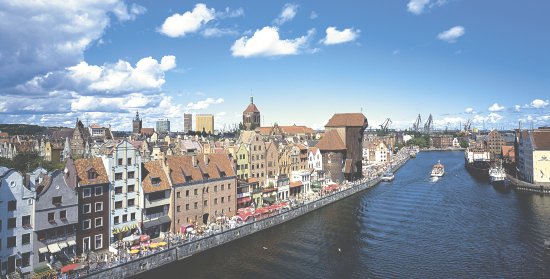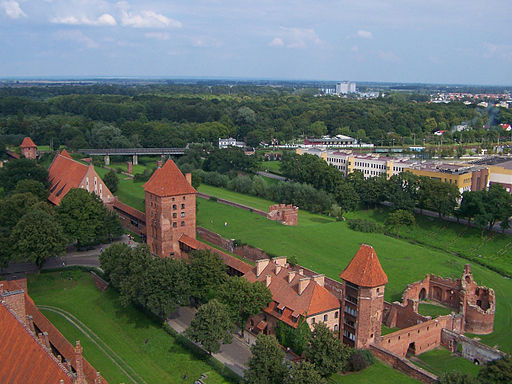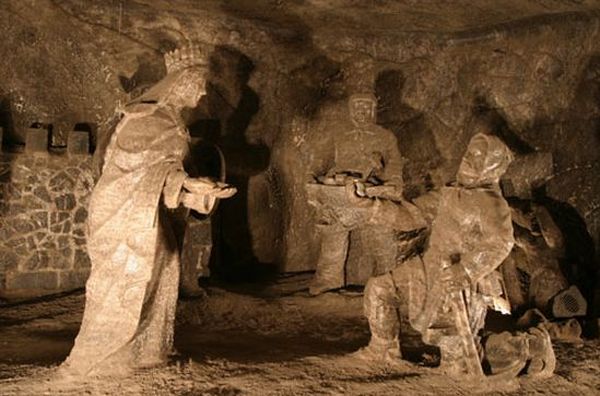

Poland, Republic of Poland - landlocked
country in the north of Central and Eastern Europe. Area - 321.7
thousand square meters. km.
The northern part of the country is a low shore of the Baltic Sea with
dunes and sandbars. Baltic Sea juts into the land of Gdańsk Bay closed
to the sea Hel oblique, Vistula Lagoon from Vistula oblique and shallow
Szczecin Lagoon. Northern and central part of the country has an
extensive Polish Lowland. To the south of it are the Silesian Lowland,
the Cracow-Częstochowa Upland, the Malopolska Upland with Sven-tokshiskimi
mountains up to 612 m and Lublin Upland up to 390 m. Between the last
two is Sandomierz Basin. Extreme south of the country is mountain ranges
in the west - the Sudetenland the highest point - Mount Snowball, 1602
m, in the east - the Western Carpathian Mountains highest point - Mount
Rysy, 2499 m.
Climate in Poland
The climate is
temperate, with the transition from the sea (in the north and west) to
continental (in the east and south-east). The average January
temperature in the lowland areas of -1 ... -5 ° C in the mountains -8 °
C, in July +19 ° C and +10 ° C, respectively. Precipitation falls in the
lowlands of 500-600 mm per year, in the Pomeranian and Masurian Lakes -
700-900 mm, in the southern mountain areas - up to 1200 mm.
The country is cut through a dense river network. Biggest p. Wisla (1047
km) runs from the Tatras to the Baltic Sea. The second largest p. Odra.
In Poland there are approx. 9 thousand glacial lakes, of which the
largest are Śniardwy (114 sq. km.) And Mamry (104 sq. km.) .27% Of the
territory is covered by forests, 20% of them - deciduous (oak, beech)
and more than 70% - pine (west and north). The largest forest (forest)
are located in the north-east (White, Bialowieza, Knyshinskaya The
August) and the south (Sandomierz, Solski). Cultivated lands occupy 47%
of the area for approx. 15% are occupied by pastures and hayfields.
There are 22 national parks with a total area of 3 thousand square
meters. km and 100 landscape parks with a total area of 20 thousand
square meters. km. The most famous are the national parks Tatrsky (with
glacial lake. Marine Eye) and Lenin (the mountains around Zakopane).
Several hundred bison, formerly lived in large numbers in these areas
and almost exterminated to beg. 20. Lives in Bialowieza reserve.
Traditions of Poland
You can get acquainted
with the country, looking at her from the window of a tourist bus or a
hotel, satisfied with the information contained in the guide. But the
emotional relationship to the places visited can only occur under the
influence of direct contact with the people living there, as it is
familiar with their customs, culture and traditions not only leaves a
trace in our memory, but also the soul.
Poles are considered people who love holidays, observant, longstanding
customs. Old rituals, especially those that date back to pagan times,
have long lost their magical character, becoming a relic of the past and
a colorful part of the game.
In this Catholic country, many customs are closely related to religion.
Easter and Christmas is a holiday, like New Year's, and the most
interesting event of Easter - Celebration of Holy Week at Calvary. Then
arrange the whole theatrical performance: entry of Christ into Jerusalem
on Palm Sunday, the crucifixion of the Holy Friday and, of course, the
resurrection of Jesus. Numerous spectators sometimes so involved that
even the attempt to free Jesus from the "Roman soldiers". And about
Bernardine monastery of the 17th century built 42 chapels, representing
the procession.
With the Easter holidays were associated with various local traditions.
In Krakow was very popular (and still is) the so called "Emaus" -
festivities that are held in memory of the way the apostles in the town
of Emaus. Street vendors laid out on the shelves of cheap shiny
ornaments, whistles, toys and sweets.
Krakow's apprentice, and the young men who came to the city to "Emaus"
from the surrounding villages, flirted with girls, slapping their willow
branches, and demonstrated their prowess in cane valiant battles. The
crowds who gathered at the Church and watched the procession of
religious brotherhoods, walking on the sidewalks with tambourines, with
the banner of brotherhood and holy images. Today, on the shelves, in
addition to traditional toys and handicrafts there, unfortunately,
printed plastic trinkets, but all the same, "Emaus" still brings great
joy and kids and adults.
Experts believe that the views of all the Easter Europe is perhaps the
oldest and interesting. November 1 everywhere celebrate All Saints Day,
November 2 and commemorate the dead. According to popular belief, the
day of commemoration of the souls of dead leaves graves, attend a
memorial service in the church and returned to the home of soy.
Souls to be easier to get into the house, relatives often open the doors
and windows, leaving food and drink, trying not to displease these
guests and enlist their help. Memorial Day - "zadushki" - very solemnly
celebrate today. Relatives gather together to visit the graves of their
loved ones, light candles.
Very popular mass pilgrimages to places of worship. Among the holy
places for Catholics, above all, we should mention the Czestochowa
monastery at Jasna Gora, the Jews in such a place is the grave of the
tzaddik in Leżajsk, and for the Orthodox - Grabarka.
Holiday, in Polish tradition occupies a very important place, is
Christmas. The special atmosphere in Rozhestva Eve - Christmas Eve (in
Poland it is called Vigilius). On this day most associated rituals,
customs and beliefs. Christmas Eve - the Polish family holiday.
Important role in creating a festive atmosphere is design a house or
apartment. The main decoration is elegant tree, which are in the
Christmas holiday. But this is one of the newest holiday traditions. The
first Christmas tree appeared in Poland in the XIX century. Mainly in
German houses and homes for residents of evangelical religion - natives
of Germany. Gradually the custom of dressing the Christmas tree spread
across Poland. Earlier, the Polish home on holidays only decorated with
branches of conifers.
Attractions in Poland
Malbork

Malbork is best known for
its castle - the largest Gothic castle, not only in Poland but also in
Europe. In addition, the strength of Malbork is the largest brick
building, which man has ever built. The fortress was built over 200
years old, dating from the 13th century.
Malbork was an example of military architecture of the Middle Ages. A
built these building Jerusalem German House Hospital Order of the
Blessed Virgin Mary, the short title of which the Teutonic Order.
Knights named the town in honor of his patron Mary Marienburg. Later
this name was transformed in Malbork.
The Teutonic Order was founded in the East during the Crusades. After
the failure that haunted knights in battles with the Muslims, Duke
Conrad of Masovia invited the Teutonic Order in the Baltic tribes to
fight the Prussians, who ravaged the land of the Polish principalities.
In 1226, Conrad has agreed with the establishment of the Order of the
Knights of the settlements on the border to defend the Duchy of Mazovia.
Wieliczka Salt Mine

Wieliczka, you can say a
suburb of Krakow, so when we got almost to the city, he immediately hit
the usual city traffic jams. In this regard, we did not even have time
for accommodation and we had to immediately go with things to Mine.
Managed to 2 minutes before closing! Still, we managed to get in, and
then the tour has already begun to flow in slow rhythm.
I'll tell you a little history first. The salt mines were opened almost
in the 15th century. Since their discovery is bonded one beautiful
legend. One Hungarian royal family decided to give his daughter in
marriage to the Polish king. This girl's name was King. And when King
went to her future husband to Poland, she threw her wedding ring in a
well near the house. When she got to the Wieliczka (then this place is,
of course, not so called), in one of the places ordered to dig a well
(like, she had a dream with omen). When the well was dug, then it got to
the bottom of a crystal object that was walled her wedding ring! Ie her
ring on groundwater proputeshestvovalo her, and returned to it in
Poland. That's how the salt mines were opened, as ring it was in a great
piece of crystalline salt. Now King is considered sacred, and her
sculptures often caught in the underground mines of Wieliczka. And the
great hall, which houses the chapel under the ground, is named in honor
of St. Kinga.
Well, now in order. First we went down for a long time on a small,
narrow staircase. I counted - 53 span. All the walls and ceiling of the
tunnel made of wooden beams, on which there is no living space - the
entire surface of the wood is painted. Wishes, names, dates, and other
writings, usually leave fans "graffiti" in all languages. Then, when we
went down to a sufficient depth (something about 60 meters) we were led
through the halls, each of which has its own attractions. And so
gradually, moving from room to room, we went down lower and lower until
it reached the level of 135 meters. Length - 3 km. This so-called
tourist trail. Then there is the route for extremists. It is 8 km long
and goes down to 162 meters. The underground halls there's even a
sanatorium for people with asthma, as considered that the air shafts is
very useful.
At first it was scary, did you go down into the earth, who knows what,
suddenly fill up, or air will be enough, and in general - who knows what
... But it was not scary. All the walls and ceilings in the halls and
passages between them, securely fastened everywhere installed
ventilation, maintained a constant flow of air and the temperature was
15 degrees. The main thing to keep and not to turn away ...
Each hall tour guide will tell you what this place is remarkable in what
century developed a "cave", allow to lick the walls, floor or ceiling
(to whom he wants.) Early on in the tour guide joked that the mines can
not do this and that, but there are some things that you can do. Namely,
each tourist can lick salt from the walls of a total weight of 2 kg of
course a joke, but in my opinion, every time though, and kissed
somewhere. Interesting fact to know, and whether or not the wall - a
lump of salt? With full responsibility - all the walls are really made
of salt
Miners - people are very superstitious and religious, as they always
have to risk your life, so it is from the 15th century underground
Storey small chapel, where miners could pray without leaving the mines.
They had to be under the ground for hours, the way up was very
difficult, so it is much easier to build a chapel right in the mine.
Initially, the chapel made of wood, but after mnogochsilennyh fires and
many victims, used to build the tree was banned. But miners our way out
- they began to make pictures of saints from what was on hand in
abundance - from rock salt. Since then, and it has begun to develop arts
carved rock salt. Now in each room are located throughout various
sculptures, statuettes, murals, etc., etc., etc., made by the miners
themselves. Even the chandeliers in mnogiz halls made of salt. However,
not stone, and from the crystal, the same as what we see at home with a
salt shaker.
Many rooms are entire compositions of mannequins depicting scenes from
the everyday work of miners. Demonstrate how they worked and what
inhumane working conditions were these people. On his back he had to
carry the bags of rock salt, huge jars of salt water (which was also
used for the production of salt), with just two pairs of arms and
conventional flywheel, they had to pull out the huge vats of water to
the surface. Also, along with people, worked in the mines and horses
that were conducted underground all his life. The most amazing thing is
that it turns out, the last horse who worked underground, was the
removal from the mine a few years ago!